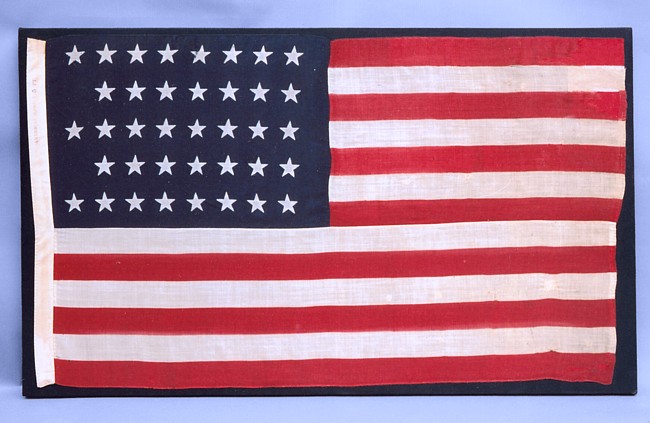
| |
38 STARS, 1876-1889, PROBABLY MADE BY THE U.S. BUNTING CO. IN LOWELL, MA |
|
| Available: |
Sold |
| Frame Size (H x L): |
41" x 68.5" strainer |
| Flag Size (H x L): |
39.5" x 66.5" |
|
| Description....: |
|
38 STARS, 1876-1889, PROBABLY MADE BY THE U.S. BUNTING CO. IN LOWELL, MA:
38 star American National flag with what is known as a "notched" configuration of stars, whereby two spaces along the hoist end were left open in anticipation of the addition of two more Western Territories.
The flag is comprised of three panels of press-dyed (printed) wool bunting that are hand-sewn together. There is a wide canvas sleeve, along which is stenciled "American Ensign 5 ft.". This flag was probably made for nautical use. Most likely, it was intended for a private ship, but these press-dyed ensigns may have been made for Naval use. The U.S. Navy was in the habit of using 13 star flags on its small boats during the second half of the 19th century, not flags with the full star count, like this one, but there were probably exceptions to that rule. This flag was probably made by the U.S. Bunting Co., in Lowell, Massachusetts, which had military contracts.
These press-dyed flags may also have made for foreign ships that sailed into American ports, hence the addition of the word "American" on the sleeve, which would have been obvious to any U.S. resident and generally excluded. The British were experts in the dying of wool and also made press-dyed flags, so foreign production is a possibility, but the stencil and construction are indicative of the U.S. Bunting Company and the notched star pattern suggests American origin.
The press-dyeing process was patented in the U.S. in 1849. In regard to wool flags, it was primarily employed during the Centennial-era by the U.S. Bunting Company of Lowell, Mass, which began making press-dyed flags for the U.S. military in 1869. The U.S. Bunting Co. was one of the first firms to successfully produce high quality wool bunting in the United States, and while its owners worked diligently to master the press-dyeing process, it was very expensive and never become a popular method of flag production. The stencil along the hoist is seen on other known U.S. Bunting Co. examples.
The 38th state, Colorado, received its statehood on August 1st, 1876. This was the year of our nation's centennial of independence from Great Britain. Although 37 was the official star count for the American flag in 1876, flag-making was a competitive venture, and no one wanted to be making 37 star flags when others were making 38's. It is for this reason that 38 and 13 stars (to represent the original 13 colonies) are the two star counts most often seen at the Centennial International Exposition, the six-month long, World's Fair event, held in honor of the anniversary, in Philadelphia. The 38 star flag became official in 1877 and was generally used until the addition of the Dakotas in 1889.
Mounting: The flag has not yet been mounted.
Condition: There is minor mothing throughout, accompanied by minor breakdown, probably from having been flown for a limited time, in the upper, fly-end corner. There is very minor staining. |
|
|
|
| Collector Level: |
Beginners and Holiday Gift Giving |
|
| Flag Type: |
|
|
| Star Count: |
38 |
|
| Earliest Date of Origin: |
1876 |
|
| Latest Date of Origin: |
1889 |
|
| State/Affiliation: |
Colorado |
|
| War Association: |
|
|
| Price: |
SOLD |
|
| |
Views: 4197 |
|
|
|

